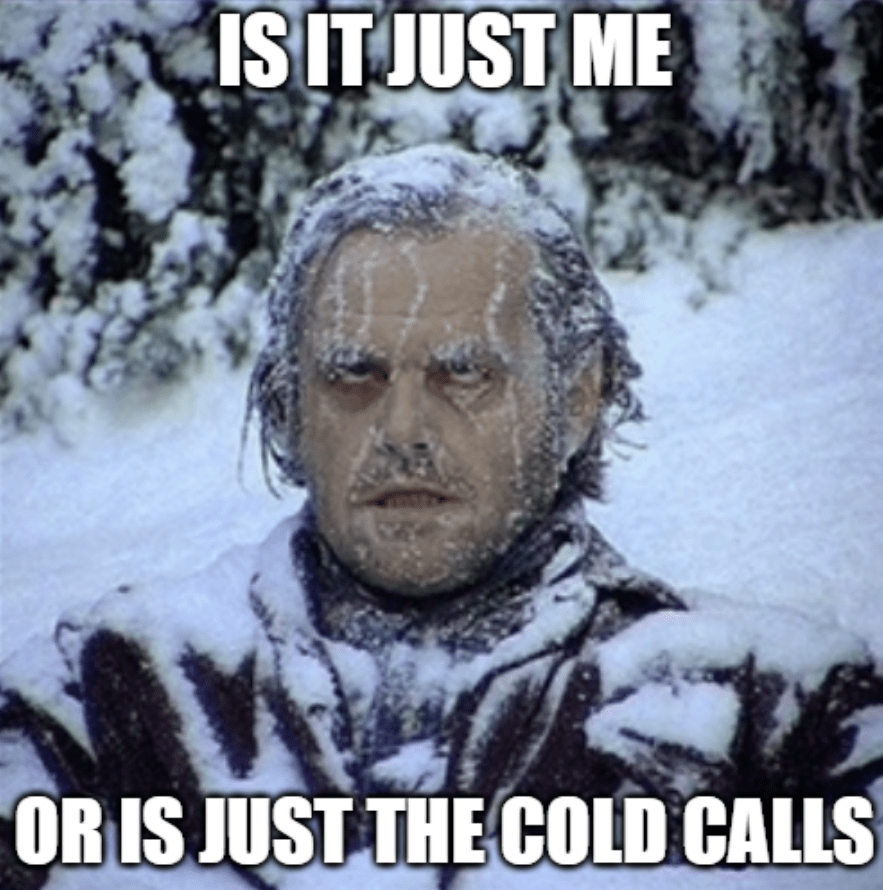

Start driving better conversations.
Novocall will be your new favorite business phone system.

Digital Marketing Executive

If your cold calls aren’t getting you hot leads, perhaps it’s time to turn up the heat!
In the world of call-driven outbound lead generation, the term “cold call” seems to pop up most often. But the reality is that there is more than one type of call.
Like cold calls, warm calls and hot calls are also types of outbound calls. And also like cold calls, they work best for very specific groups of prospects and leads.
So how does each work? Let’s see, shall we?

This type of outbound call involves calling a prospect that you have no existing relationship with to sell them your product or service.
The call is ‘cold’ because your prospect has never heard of your company, product, or service. There is a lack of a ‘warm’ relationship.
While many deem cold calling to be ineffective, there are still many businesses that involve cold calling in their lead generation strategy. Companies that mainly use cold calls in their sales strategy are those that sell high-value products or provide high-touch services.
Cold calling gives you the opportunity to engage with prospects in a one-on-one conversation. You make the first move by reaching out to the prospect to introduce your product and hopefully, fix an appointment.
You provide the human interaction needed to build a relationship with prospects and get them to trust a company they’ve never heard of before.
More than 50% of prospects actually want to see how your product works on the first call. So, cold calling is a good way to give prospects a walkthrough or live demonstration of your product and get them interested in what you have to offer.
You’re able to easily unveil the real value of your products or services over the phone as compared to through emails or advertisements.
Although you can buy lists or generate random contacts to speed up the cold call process, there is an extremely low chance that these prospects fall within your ideal customer profile (ICP).
You should do some basic research such as finding out your prospects’ demographics to give you a better idea of who you’re reaching out to. You can also make use of LinkedIn to do a quick check on their role in the company and the industry they work in.
This can help you identify if they match your ICP and whether they could be a potential customer. Having such information on hand can also help you build rapport with them.
💡 Bonus tip: Once you’ve got your list of prospects, do check it against the National Do Not Call (DNC) Registry as there are approximately 229 million phone numbers listed.
Draft a quick pitch that you can easily refer to and use as a guide to help you communicate the key points of your message.
But, you shouldn’t heavily rely on the script as that would make the conversation seem robotic.
Try to keep it personal by focusing on the current prospect’s needs as an individual, so make sure to adjust your pitch accordingly and not directly read off the script.
💡 Bonus tip: If you don’t have time to draft a script, do up a simple checklist of all the key points you have to mention during your call.
Keep in mind that the prospects you’re calling have no idea who you are or have no initial interest in your product or service.
You only have a short window to keep your prospects hooked. It’s in the first 30 seconds that you have to establish interest for prospects to stay on the line and listen to you.
So cut the small talk and go straight into the value proposition of your product. This will help your prospect identify if you’re relevant to them and whether you’re able to provide a solution to their problem.
💡 Bonus tip: First impressions are also the last. Always remember these 3 things when speaking to your prospects for the first time: volume, pacing, and tonality.
The goal of the first call isn’t to get the prospect to purchase from you immediately. Such prospects are really hard to come by.
Instead, you should focus on gaining information about your prospect, introducing them to your business, and possibly scheduling an appointment at a later date.
Build a relationship with your prospect and gain their trust, not shove your product into their faces.
💡 Bonus tip: Taking the advice from a Salesforce team lead Edouard Obin, use a consultative sales approach to avoid hard selling. “Salespeople should be consultants first”.

You would typically call it warm calling when you’re connecting with a prospect who you’ve had some prior contact with.
The stronger the connection between you and the prospect, the warmer the call is.
You could have engaged with these warm prospects through your website, at an event, or through social media.
Warm calling is more personalized as you acknowledge the connection between yourself and the prospect. Also, you can address the prospect by their name since they had some contact with you beforehand.
For the obvious reason that this outbound call type scores your team appointments easier. You are 4.2 times more likely to get an appointment if you make a personal connection with the prospect before the call.
As you’ve already established some sort of contact with the prospect before the call, you have already built a certain level of trust with them. Because of this, the prospect will be more willing to listen to your pitch.
Their familiarity with your business also results in less time needed to educate them about your product or service, and more of a focus on the value and benefits you can bring them.
Warm calls tend to be devoid of common cold calling problems like poor lead information, high rejection rates, and bad timing.
Do personalized research on your prospects and their companies to know exactly what their pain points are and how you can provide a solution for them.
Afterall, you can’t deliver value if you don’t know anything about your prospect.
Gathering valuable information such as their company’s sales process, company’s mission and vision, and their value proposition gives you the chance to tap into their desire to purchase from you.
It’ll also make it easier to establish relationships and sell to them.
💡 Bonus tip: Study your most successful customers and identify any key similarities or patterns that they all share. This gets half the research done.
Once you’ve spoken to your prospect over the phone, don’t just forget about them and move on to the next contact on your list.
Following up with an email enhances your visibility because they’ll open your email now that your name is familiar to them.
Follow-up emails have a 62% open rate, so don’t waste precious opportunities.
Keep the email personal and tailored to each prospect that you call. It’s also good to thank them for their time and provide subtle hints about your solution to remind them about it.
Don’t forget to ask them for a follow-up call in the email.
💡 Bonus tip: Subject lines containing the word “call” work best (62% open rate, 35% reply rate), instead of asking them to put some time on their “calendar” (33% open rate, 10% reply rate).
After following up with an email, your chances of eliciting a response are higher if you follow up with a call. As long as you weren’t given a flat “no”, you should follow-up until you get a response.
However, keep in mind that you shouldn’t come off as too spammy. Spread out your calls over a few days so you aren’t “harassing” your warm prospects.
Here’s an example of a follow-up schedule that you can use as a guide.

💡 Bonus tip: There is a best time to cold call. Call prospects back these times to catch them when they’re the most receptive.

Hot calls are made when your prospect is highly interested in your product or service and is ready for direct contact to make a sale.
They could have submitted a form on your website or emailed you to indicate their interest to purchase your product.
Compared to the first 2 outbound call methods, there is little need to “warm” up these prospects from hot calls. They’ve probably already done some research about your company and felt that it could be a good fit for them.
The focus of the conversation is to build a relationship with them and evaluate their current budget and needs.
This type of outbound call is a great way to capture leads at the peak of their interest and ensure that they don’t fall through the cracks.
By capturing prospects when they’re hot, you don’t have to do much “warming up”. Also, it takes less convincing on your part and can still get a higher closure rate as compared to the first two methods.
However, it’s worth noting that hot prospects don’t come by often. So, businesses still practice cold and warm calling to acquire leads.
By tracking visitors’ behaviors, you can easily identify hot prospects.
For example, if a visitor frequently visits your pricing page, it could mean that they have a high level of interest and are considering your product or service.
Also, by monitoring web pages that drive the most traffic, you can identify which page has the most visitors.
You can then add compelling call-to-action or pop-up subscriptions to these pages to collect the visitor’s email address.
Once you’ve gotten their email address, drop them an email and arrange for a call ASAP!
💡 Bonus tip: If they’re not ready for a call yet, don’t give up! You’ve already got their email address, so keep them in the pipeline and start including them in your drip campaigns.
If your hot prospects have some burning questions (no pun intended) about your product, why keep them waiting?
Because they’re already interested in your product and are ready for direct contact with your business, they’ll probably appreciate a quick call to answer any questions instead of endless back and forth messages through email or live chat.
So, you should provide the option for a call-back on your website.


For example, Novocall’s call-back widget allows your prospects to request for a call from your rep either immediately or at their own convenience.
They can even choose the reason for calling, which gives your reps more time to prepare for the possible questions they will ask.
Also, as 77% of customers believe that a phone call is the most effective way to get an answer quickly, having calendar integrations in your call-back solution helps to reduce the time taken for an instant call-back.
💡 Bonus tip: Find a call-back software that integrates with your existing customer relationship management software. This allows you to store data of all new outbound calls on one platform.
It’s evident that these 3 outbound call methods are very different. Let’s quickly review them.

So, which outbound call method should you use? Well, all of them!
There will never be a clear-cut winner as each type of outbound call was designed to target very specific prospects and lead profiles. Each also helps the business achieve a different goal.
Comparing them to select the best one is like comparing an apple to an orange. It just doesn’t quite make sense.
We hope that this article has given you a better understanding of the different outbound call methods. To find out more about outbound calls, do check out our other articles to keep yourself informed!

Faye is a digital marketing executive at Novocall. When she’s not busy writing articles for Novocall’s blog, she spends her time baking and playing with her dogs.
Discover more
Subscribe to our blog
Get insights & actionable advice read by thousands of professionals every week.

